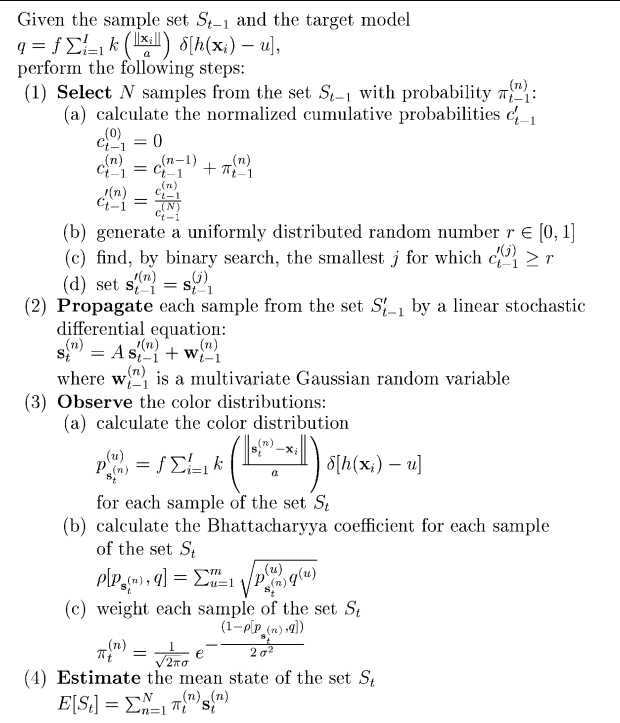标签:
粒子滤波中最重要的一个过程就是重要性重采样, Sampling Importance Resampling (SIR).
这篇博客基于粒子滤波的物体跟踪讲的挺形象的 :) 。 这里拿过来记录一下。
初始化阶段
基于粒子滤波的目标追踪方法是一种生成式跟踪方法,所以要有一个初始化的阶段。对于第一帧图像,人工标定出待检测的目标,对该目标区域提出特征。论文里将图像的HSV空间划分成不同的bins,然后统计直方图。另外
To increase the reliability of the color distribution when boundary pixels belong to the background or get occluded, smaller weights are assigned to the pixels that are further away from the region center by employing a weighting function

 是到区域中心的距离,所以直方图分布可如下计算
是到区域中心的距离,所以直方图分布可如下计算

 是归一化因子,
是归一化因子, 是区域半径,
是区域半径, 是示性函数,是将加权后的值添加到对应的区间内。
是示性函数,是将加权后的值添加到对应的区间内。
搜索阶段 - 放狗
现在已经知道了目标的特征,然后就在目标的周围撒点(particle),即放狗。放狗的方法有很多。 如a)均匀的撒点;b)按高斯分布撒点,就是近的地方撒得多,远的地方撒的少。论文里使用的是后一种方法。每一个粒子都计算所在区域内的颜色直方图,如初始化提取特征一样,然后对所有的相似度进行归一化。文中相似性使用的是巴氏距离。
重要性重采样
根据第2阶段获得的相似度重新撒粒子,相似度高的粒子周围多撒,相似度低的地方少撒。这个过程其实可以重复几次,但为了检测速度,重采样一次也可以。
状态转移
对上一阶段多次重采样后获得的粒子计算下一时刻的位置。

 是多元高斯分布变量。
是多元高斯分布变量。
观测阶段
i. 在 出计算概率颜色直方图
出计算概率颜色直方图
ii. 计算各个粒子和目标的巴氏距离
iii. 更新每个粒子的权重
决策阶段
每个粒子都能够获得一个和目标的相似度,这个相似度体现了该区域是目标的置信度,可以把所有例子使用相似度加权后的结果作为目标可能的位置。

标签:
原文地址:http://www.cnblogs.com/YiXiaoZhou/p/5877398.html